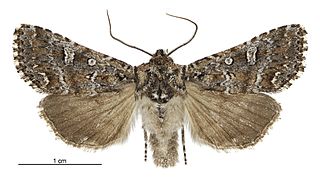
Ichneutica lithias is a moth of the family Noctuidae. This species is endemic to New Zealand. It is a small moth but distinctive as a result of the markings on its forewings. Although this species is widespread in the South Island, it has only been collected in the Rangipo Desert in the North Island. The species prefers habitat that is scrubland ranging in altitude from coastal to alpine. Adults are on the wing from October to April and larvae have been collected and reared on the New Zealand endemic plant species Melicytus alpinus.

Ichneutica morosa is a moth of the family Noctuidae. It is endemic to New Zealand and is found in the southern parts of the North Island and throughout the South Island. I. morosa is common in the eastern parts of both those islands and also in Fiordland. I. morosa can be found from altitudes ranging from lowlands to the alpine zone. I. morosa is absent from the range of its closely related species I. mustulenta, that is from the northern North Island. The larvae of I. morosa are known to feed on Poa astonii and also on other Poa species including introduced species. As well as its standard form the adult moths have a grey colour morph with the head and thorax being a grey and mottled brown, and the forewing being a pale greyish ochreous to a deep brown, suffused with grey. I. morosa can be confused with I. mustulenta and I. lignana. Adults are on the wing from November to April.

Ichneutica pelanodes is a moth of the family Noctuidae. It is endemic to New Zealand and has been found in scattered locations in the North, South and Stewart Islands. I. pelanodes is easily confused with I. skelloni as the two species are visually extremely similar. In the North Island though the range of the two species appears not to overlap. Generally of the two species I. pelanodes tends to be darker in appearance. I. pelanodes inhabits wetlands but the life history of this species is unknown as are the host species of its larvae. Adults are on the wing from October to February and are attracted both to sugar and light traps.

Ichneutica petrograpta is a moth of the family Noctuidae. This species is endemic to New Zealand where it is found in the southwest districts of the South Island, including Westland, Otago Lakes and Fiordland. It is very similar in appearance to I. mutans. It inhabits tussock and shrubland in the alpine to subalpine zones. Adults of I. petrograpta are on the wing from December to February and are attracted to sugar traps. The life history of this species is unknown as are the host species of its larvae.
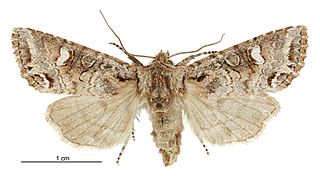
Ichneutica sericata is a moth of the family Noctuidae. It is endemic to New Zealand. This species is variable and difficult to distinguish from I. skelloni specimens. It is known from the southern part of the South Island and from Stewart Island. There has been one specimen collected in Taranaki but although Robert Hoare determined the species, he expressed reservations given the location of collection. I. sercata inhabits shrubland at altitudes of between 470 and 900m. The life history of this species is unknown as are the host species of its larvae. The adults of this species are on the wing in August at Stewart Island and in November and December in the South Island.
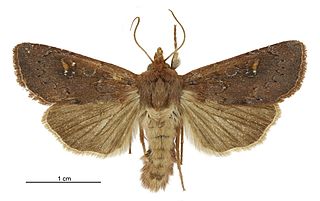
Ichneutica alopa is a moth of the family Noctuidae. It is endemic to New Zealand and is found in the central and southern parts of the North Island as well as in the South Island. It inhabits tussock grasslands and wetlands and can occur at ranges from the alpine zone down to almost sea-level. The life history of this species is unknown as are the host species of its larvae in the wild. Larvae of this species have been raised in captivity on Sphagnum moss as well as on species in the genus Raoulia. Adults of this species are on the wing from late January to April and are attracted to light and to sugar traps. I. alope can be confused with I. agorastis, I. micrastra or I. sapiens but the latter three species can be distinguished externally from I. alope through differences in size, forewing pattern and the antennae of the male of the species.

Ichneutica paraxysta is a moth of the family Noctuidae. It is endemic to New Zealand. This species is very similar in appearance to its close relative I. acontistis but as the range of the two species do not overlap this is unlikely to cause confusion. I. paraxysta is only found in the North Island at the subalpine zones in the Mount Taranaki region and at Mount Ruapehu. It prefers tussock grassland and shrubland habitat. The life history of this species is unknown as are the host species of its larvae however it has been hypothesised that the larval host plants are species in the genera of Poa and Festuca.

Ichneutica epiastra is a moth of the family Noctuidae. It is endemic to New Zealand and is found throughout the North, South and Stewart Islands. This species prefers open habitats such as wetlands, dunes and forest clearings. Eggs are laid in the summer or autumn and larvae feed during winter and spring. The larval host species are found within the genus Austroderia. The adult moths are on the wing between October and February. Adult I. epiastra can possibly be confused with the similar species I. arotis and I. haedifrontella however there are differences in appearance that enables I. epiastra to be distinguished from these two species. In particular I. epiastra has long sharp-tipped ‘horns' on its head that are diagnostic. The adults of this species appear reluctant to be attracted to light although they do come more frequently to the brighter mercury vapour traps.

Ichneutica cuneata is a moth in the family Noctuidae. It is endemic to New Zealand. I. cuneata is found in and around the Tongariro National Park in the North Island and throughout the South Island. Specimens found in Tongariro National Park tend to be darker in appearance than South Island specimens but as their colour is variable, and antennae and genitalia of both species are consistent, they are not now regarded as a separate species. I. cuneata inhabits tussock grasslands and shrublands in alpine and subalpine zones. The adults are on the wing from December to April and can be found flying during the day. The life history of I. cuneata is unknown as are the specific host species of its larvae. However larvae of I. cuneata are said to feed on herbaceous plants. The adults of this species also pollinate native species such as Myosotis macrantha.
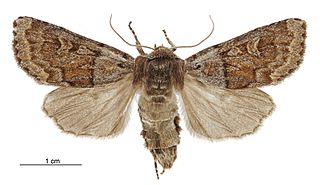
Ichneutica marmorata is a moth of the family Noctuidae. This species is endemic to New Zealand and can be found in the North Island at the Tongariro National Park and at Puketitiri near the Kaweka Range. In the South Island it is widespread. It prefers alpine to subalpine habitat but occurs down to sea level altitudes in more southern locations. Adults are on the wing from late October to February. Larvae of this species may use tussock grasses in the genus Chionochloa as their host and they have been reared on Festuca novae-zelandiae.

Ichneutica disjungens is a moth of the family Noctuidae. This species is endemic to New Zealand and can be found on the central volcanic plateau of the North Island and in the eastern as well as the south western parts of the South Island. I. disjungens inhabits tussock grasslands in the alpine and subalpine zones. The hosts of the larvae of this species include Poa cita, P. colensoi, and Festuca novae-zelandiae. The adults of this species are distinctive and are unlikely to be confused with other species. They are on the wing between October and March.
Ichneutica subcyprea is a moth of the family Noctuidae. This species is endemic to New Zealand. This species is very similar in appearance to I. chlorodonta. It feeds on fern species in the genus Tmesipteris. It is the only New Zealand noctuid known to exclusively feed on ferns. The preferred habitat of this species is humid native forest and the adults are on the wing from September to December.
Ichneutica dundastica is a moth of the family Noctuidae. This species is endemic to New Zealand. As at 2019 this species has only been found near the Dundas Hut in the Tararua Range near Wellington. It inhabits alpine shrubland and is attracted to light. The life history of this species is unknown as are the host species of its larvae however adults are on the wing from late November to early December. The female of the species is larger and more conspicuous than the male.
Ichneutica cornuta is a moth of the family Noctuidae. This species is endemic to New Zealand and is only found in the South Island, in and around the Southern Alps. I. cornuta is very similar in appearance to pale forms of I. arotis. It is easy to confuse the two species as their ranges overlap. Male I. cornuta can be distinguished as it has longer pectinations on the antennae and the female lacks the dark scaling that can be found on the thorax of the I. arotis. There are also subtle differences in the forewing patterns of the two species. The life history of this species is unknown as are the host species of its larvae. Adults are on the wing from January to April.
Ichneutica lyfordi is a moth of the family Noctuidae. This species was named in honour of its first collector, Brian M. Lyford, and is endemic to New Zealand. It is only known from the Von Valley in the Otago Lakes area of the South Island. As at 2021, only the male of the species has been collected. The life history of this species is unknown as are the host species of its larvae. Adults are on the wing in February and are attracted to light.
Ichneutica prismatica is a moth of the family Noctuidae. This species is endemic to New Zealand. The species is ochreous coloured with distinctive pale streaks on its forewings and a white fringe on its hindwings. It is similar in appearance to I. paraxysta but I. prismatica is smaller, lighter bodied and has narrower wings. Also I. prismatica can only be found in the South Island where as I. paraxysta is only known from the North Island. I. prismatica has mainly be collected in the Central Otago region but has also been recorded in the Otago Lakes and the wider Dunedin regions. It inhabits tussock grasslands and wetlands. The life history of this species is unknown but the larval host species are found in the genus Chionochloa. Adults are on the wing in December and January and have been recorded as flying during the day.
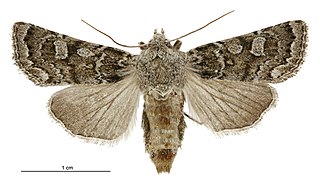
Ichneutica sistens is a moth of the family Noctuidae. This species is endemic to New Zealand. It can be found in the central North Island and throughout the South Island, although it is more common on the eastern side of that latter Island. It is very variable in both colour and size. I. sistens prefers open habitat such as tussock grasslands, dunes and braided rivers. Larval host species include grasses in the family Poaceae and include species in the genera Rytidosperma and Elymus, as well as Poa cita and Agrostis capillaris. Adults are on the wing from January to May and are attracted to light.
Ichneutica inscripta is a moth of the family Noctuidae. This species is endemic to New Zealand. This species is found from south Auckland to Taranaki in the North Island. It prefers to inhabit dense native forest with high rainfall at higher altitudes. The life history of this species is unconfirmed as are the host species of its larvae but is likely to be similar to its close relative I. infensa. This species is very similar in appearance to its close relative I. infensa but has more strongly patterned forewings. The adults of this species are on the wing from late October to January.
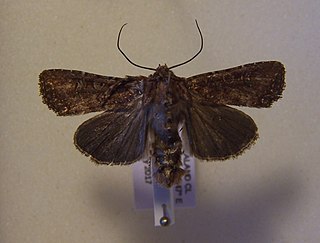
Ichneutica mustulenta is a moth of the family Noctuidae. This species is endemic to New Zealand is widespread throughout the North, South and Stewart Islands. I. mustulenta prefers damp native forest in the west of the North and South Islands. Its range only overlaps with its close relative I. morosa in a few places such as Taranaki. The life history of this species is unknown as are the host species of its larvae. However it is assumed that the larval hosts of this species will be grasses similar to its close relatives in the same genus. Adults of this species are on the wing from January to March.
Ichneutica supersulcana is a moth of the family Noctuidae. This species is endemic to New Zealand and is only known from the Tararua Ranges and at Tongariro National Park. This species has been collected in subalpine tussock grasslands as well as subalpine shrubland and at the margins of Fuscospora cliffortioides forest. The life history of this species is unknown as are the host species of its larvae. The adults of this species are on the wing in February and are attracted to light. It appears to be restricted to higher altitudes in comparison to its close relative I. sulcana.I. sulcana and I. supersulcana are very similar in appearance with no reliable visible differences between the two having been discovered. However, there are distinct differences in the male abdomen and genitalia of these two species.













